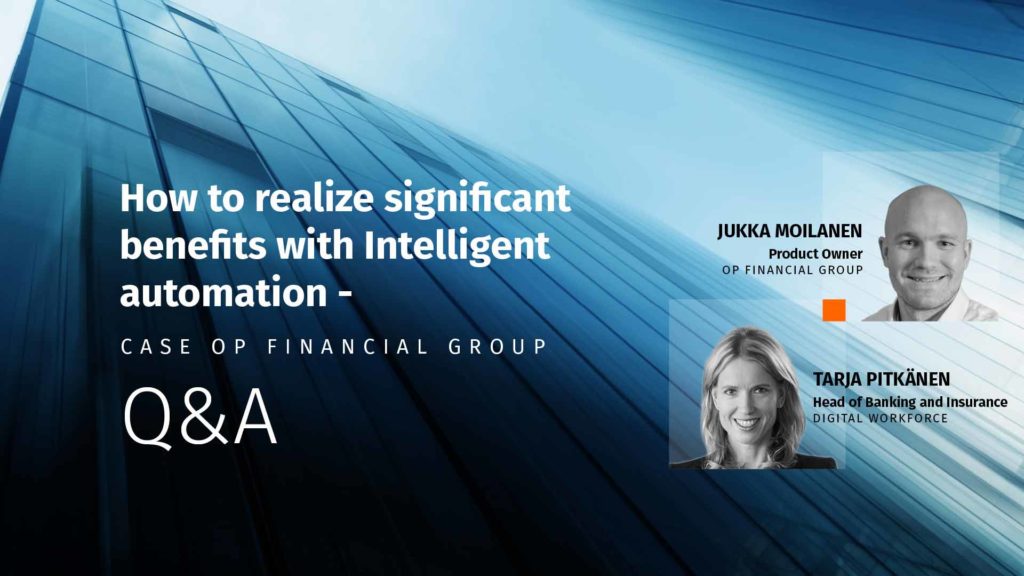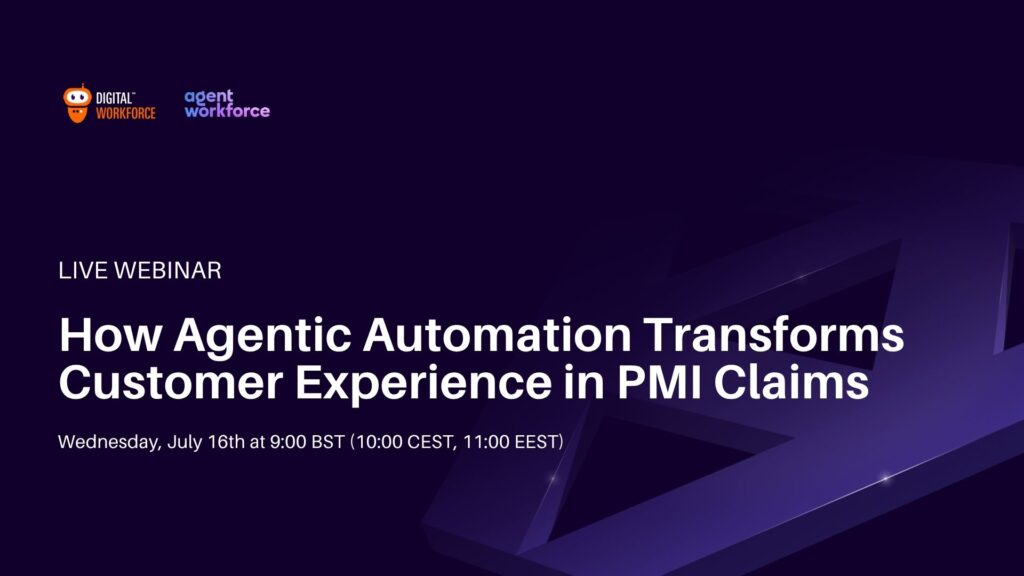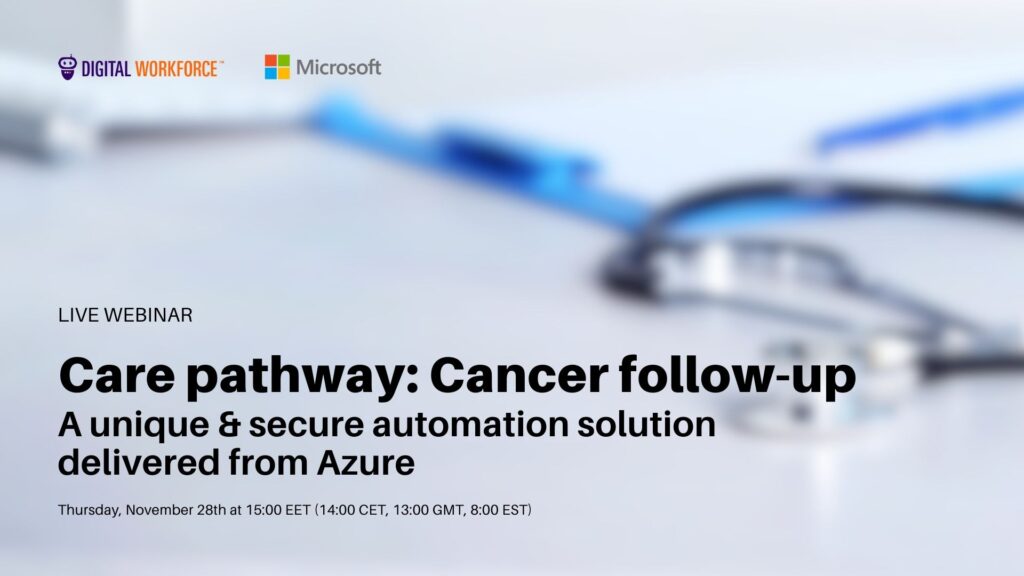Webinar Q&A with OP Financial Group: How to realize significant benefits with Intelligent automation

Webinar Q&A with OP Financial Group
We recently held a webinar with Jukka Moilanen, Senior Product Owner of Robotics at OP Financial Group, to share how OP has used RPA and other cognitive tools to produce impressive business results. Jukka discussed the setup of OP’s extensive automation program and presented a use case from OP’s award-winning Robotic Process Automation (RPA) area where RPA has been used to help grow OP’s consumer loan business.
Throughout the live webinar, we received lots of great questions and since we couldn’t get to all of them during the session, we decided to make a Q&A post covering the rest questions. In case you missed the webinar, you can see it from the recording any time you want.
Webinar key takeaways
- How OP began its automation journey?
- What is OP’s management model for intelligent automation?
- What are OP’s main objectives for process automation?
- What are the different process automation tools used at OP?
- What have been the learnings from using different tools?
- How Intelligent Automation has benefited the business growth for the consumer loan business?
Check out below all the answers to the questions to OP’s Senior Product Owner of Robotics, Jukka Moilanen.
Webinar Q&A with OP
Are you re-engineering your RPA automations to be more granular and orchestrating them with a workflow engine?
We have not designed our RPA solutions for any specific workflow engine but aim to design them to work as self-contained units. We have looked at the benefits of re-engineering our processes, but due to the number of existing workflows, it is an investment we need to consider carefully.
How did you describe and model the automatized processes?
We have quite a detailed development process, in which we have specific templates to be used in different stages of development. For instance, in the process analysis stage, we have specific criteria that need to be met before the development can be considered. I think the main thing is to ensure that the documentation serves its purpose – be it compliance with regulation, or informing stakeholders on what systems are automated and how.
How do you currently measure or assess Human Savings within a workflow/functional process?
It depends on the process, and it is important we do it in coordination with the subject matter experts. Sometimes it’s just estimation based on data we have regarding the volume and time it takes to do the manual work. Sometimes we know that some group of people can do something more productive, for example, at the start of every month after the automation is in place. So we look at it on a case per case basis, but we estimate the impact to our best ability for every process.
How do you find processes that are suitable for automation?
There are a lot of paths to find suitable candidates. In more mature business areas, the people working in process development are already capable of doing that work for us. In those cases, we work with them to refine their ideas and educate them on the different opportunities. For newer technologies and new business areas, we can do process discovery work with the business areas to find use cases, for example, by observing the processes. We are also implementing process discovery and process mining tools to analyze and find suitable candidates. It is still very much manual work, so there are at least some things that we cannot yet automate.
How much did you struggle, and how did you overcome people entering data in the wrong way into your system, and did that affect RPA?
When designing process automation solutions, it is really important to consider data quality, especially when dealing with user inputs. We aim to standardize and validate user inputs but also try to minimize the number of user inputs when possible. I wouldn’t say that we’ve struggled with this, but we’ve had to consider how this impacts our processes carefully.
If you would have to state the top 3 main benefits of automatisation in one word, what would those be?
Agile process efficiency.
IPA poses many requirements for data quality and management (etc. where is master data). How do you handle this issue?
We have integrated our stakeholders into our development process, enabling us to consider the organization’s various requirements and dependencies. We aim to utilize as many existing procedures as possible, so that process automation solutions would mostly use what is already in place in the business processes, including data management. As for data quality, it is important that we consider how the automation affects data quality, both in terms of risks and possibilities.
What has been the biggest obstacle and constraint in automating processes? And how have you tackled them?
It’s difficult to name a specific obstacle, but I think that the difficulty relates to the process maturity and readiness to change. To be successful in automation, we need to be able to develop the process and ensure that the new process is truly adopted. Automation is only one part of that change; most of it is process understanding and development.
Is it important to prioritize higher-valued processes above lower-valued processes? What message does this send to Business?
It is important that we prioritize processes that have the most impact. However, it is important to have a thorough understanding of what creates value. If we have really specific metrics that don’t really represent customer value, we are losing value in prioritization. Sometimes it is also important to prioritize lower-impact processes, as it can lead to more value in the long term by enabling new cases for automation down the line.
How are you leveraging quality assurance as a part of your intelligent automation development efforts?
QA is a key part of development. First, development process includes a hypercare period after release, in which the business has the support of the developer to fix any issues. Second, we are implementing a process through which we can ensure that existing, older processes are still valid and done according to our best practices. Third, we include process quality in our KPIs, which provides us the incentive to keep working on solutions already in production.
As the topic is about intelligent automation, what intelligence was incorporated in the automation?
We did not have time to go to this topic in detail in the webinar, but we have implemented AI in some RPA processes. For instance, we utilize RPA to deliver data from an AI model to the end-users in a few processes, but we are constantly looking for new options to utilize intelligence in automation. For example, document structuring is one area where AI shows promise in terms of process automation in the near future.
Business Process Management tools – which ones did you find useful for which improvement areas?
I think that regardless of your choice of tool, you should have the capability to manage, orchestrate, and automate complex processes and cases. Business process management tools and RPA complement each other, and it is important to evaluate the processes critically to look at how to deliver the value in each case best.
Do you feel that the use of Robotic Desktop Automation is a democratizing process for the users? Does RDA democratize the company?
Robotic Desktop Automation itself is not automatically democratizing. It does, however, increase the impact of process automation on new stakeholders – the end-users. This requires that we are more open to feedback and involve the end-users more in the process, so it has democratized the development process for us. Desktop automation can be, of course, connected to citizen development, which I believe has a big impact through democratizing process development and automation in the organization.
Do you have any other automation ongoing with RPA, for example, Microsoft Power platforms?
In addition to our Process Automation toolkit, which I presented at the webinar, there are, of course, some automation solutions in use that don’t fall into those technology areas. We are looking to enable, for example, citizen development, which can deliver value through innovative solutions on a smaller scale and democratize automation.
How big is your CoE? Are all 60 people in CoE or a part of it?
The 60 person CoE includes the people working in process automation management, operations, development, etc.
How do you take care of the maintenance of production processes?
We have an operations team who are responsible for the processes in production. The operations team can do maintenance themself, or coordinate the work with our developers.
How does BPM help E2E automation?
By providing the capability to orchestrate processes and data flows between tasks and organizations. It’s not always a matter of using a BPM solution, but using one can offer benefits through standardization, shorter lead times, etc.
What are the business processes in the insurance value chain that were automated using RPA and IPA?
There are too many to list all of them, but a few examples, we have automated the sending of insurance quotes and the product information documentation related to them as well as data transfer between systems for our claim processes.
Is there a reason why process mining is not in your process automation toolkit?
Is it in your process development toolkit? I consider process mining more related to process development. Process mining is definitely valuable for automation as well, but I think its main value is in providing better insight into processes.
More webinars
New guide!
Setting Up World-Class RPA Maintenance
Why you need it and how to set it up




